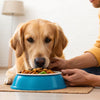Why Does My Dog Not Gain Weight? Understanding Canine Weight Management
- Houndsy
Table of Contents
- Introduction
- Understanding Your Dog's Ideal Weight
- Common Reasons Why Dogs Don’t Gain Weight
- Steps to Help Your Dog Gain Weight
- Monitoring Your Dog’s Progress
- Conclusion
Introduction
Have you ever looked at your furry friend and wondered why, despite eating well, they just don’t seem to gain weight? You're not alone. It's a common concern among dog owners, and understanding the underlying reasons can be crucial for your dog’s health. According to recent studies, around 10% of dogs are considered underweight, which can indicate potential health issues. The good news is that by recognizing the signs and understanding the causes of weight loss, we can take proactive steps to help our canine companions.
In this blog post, we will explore various reasons why dogs might not be gaining weight, even when they seem to have a healthy appetite. From dietary issues to potential health problems, we’ll cover everything you need to know to assess your pet's weight situation effectively. By the end of this article, you will have a comprehensive understanding of how to monitor your dog’s weight and what actions to take if you notice they're not gaining as expected.
So, let’s dive into the world of canine nutrition and health, addressing the question: Why does my dog not gain weight?
Understanding Your Dog's Ideal Weight
Before we can address the question of why your dog isn't gaining weight, it’s essential to understand what a healthy weight looks like for them. Each dog breed has different weight ranges, and even within breeds, individual dogs can vary significantly.
Assessing Body Condition Score (BCS)
The Body Condition Score (BCS) is a useful tool that veterinarians and pet owners can use to assess if a dog is at an ideal weight. The scoring system ranges from 1 (underweight) to 9 (obese), with a score of 4-5 being ideal for most breeds. Here’s a quick guide to help you evaluate your dog:
- 1-2: Underweight. You can easily see and feel the ribs, spine, and pelvis.
- 3: Acceptable. Ribs can be felt with slight pressure, and waist is visible.
- 4-5: Ideal. Ribs are easily felt, and there is an hourglass shape from above.
- 6-7: Overweight. Ribs are difficult to feel, and there is no waist.
- 8-9: Obese. Large amounts of fat cover the ribs, and there is no waist.
If your dog falls into the underweight category, it may be time to investigate why they aren’t gaining weight.
Factors Influencing Weight
There are numerous factors that influence a dog’s weight. These include breed, age, metabolism, activity level, and overall health. For instance, high-energy breeds like Border Collies or Retrievers may have different nutritional needs compared to lower-energy breeds like Bulldogs or Shih Tzus.
Common Reasons Why Dogs Don’t Gain Weight
Understanding the reasons behind weight loss or lack of weight gain is key to addressing the issue effectively. Below, we explore the most common causes:
1. Dietary Issues
Inadequate Caloric Intake
One of the most straightforward reasons your dog isn’t gaining weight could be that they aren’t consuming enough calories. Dogs typically require food that is high in protein and fat to gain weight. If you’re feeding your dog low-calorie kibble or not enough food overall, they might not be able to put on weight.
Low-Quality Dog Food
The quality of the food matters just as much as the quantity. Many commercial dog foods are filled with fillers that provide little nutritional value. Switching to a high-quality, nutrient-dense food can make a significant difference. Our Houndsy Kibble Dispenser can help you measure out the perfect portions, ensuring your dog receives adequate nutrition without overfeeding.
2. Health Problems
Gastrointestinal Disorders
Conditions like inflammatory bowel disease, malabsorption syndromes, or gastrointestinal infections can prevent your dog from absorbing the nutrients they need, leading to weight loss or failure to gain weight. Observing your dog’s stool can provide insights; diarrhea or irregular stool may indicate a deeper issue.
Dental Problems
If your dog is experiencing dental pain, they may avoid eating or chew less effectively, which can lead to weight loss. Signs of dental disease include bad breath, difficulty chewing, and excessive drooling. Regular dental check-ups and good oral hygiene can help maintain your dog's health.
Endocrine Disorders
Conditions such as hypothyroidism or diabetes mellitus can lead to weight loss despite a seemingly normal appetite. In cases of diabetes, dogs might drink more water and urinate more frequently, which often goes unnoticed. If you suspect an endocrine issue, consult your veterinarian for appropriate testing.
Parasites
Intestinal parasites, like worms, can rob your dog of essential nutrients, leading to weight loss. Regular deworming and fecal checks can help keep these pesky invaders at bay.
3. Stress and Anxiety
Just like humans, dogs can suffer from stress and anxiety, which may lead to a decrease in appetite or changes in eating behavior. Factors contributing to stress could include changes in the household, loud noises, or even the arrival of a new pet. If your dog seems anxious, consider ways to create a more calming environment, such as providing a quiet space and engaging in regular playtime.
4. Age and Breed Considerations
As dogs age, their metabolism can slow down, and they may require fewer calories. However, senior dogs also face a higher risk of health issues that may affect their weight. It’s essential to monitor your senior dog’s weight closely and consult with your veterinarian about appropriate dietary adjustments.
Different breeds have unique characteristics that can impact weight. For example, Greyhounds are naturally lean, so their weight may be lower than other breeds, while larger breeds may gain weight differently.
Steps to Help Your Dog Gain Weight
If your dog is underweight, it’s important to take action. Here are some steps to consider:
1. Consult Your Veterinarian
Before making any changes, consult with your veterinarian. They can help identify any underlying health issues and recommend appropriate dietary changes. It's also crucial to rule out any serious conditions that could be causing your dog's weight loss.
2. Evaluate and Adjust Feeding Habits
- Increase Portion Size: Gradually increase your dog’s food portion by 10% and monitor their weight weekly. If they still aren’t gaining weight, increase the portion again.
- Frequent Small Meals: Instead of one or two large meals, try feeding your dog smaller portions more frequently throughout the day. This can encourage them to eat more.
- Quality Over Quantity: Choose high-quality dog food that is rich in protein and fat. Look for options that list meat as the first ingredient and avoid fillers.
3. Enhance the Food
- Add Toppers: Consider adding high-calorie food toppers to your dog's meals, such as boiled chicken, brown rice, or pumpkin puree. These can entice your dog to eat and provide additional calories.
- Moisture Matters: If your dog is reluctant to eat dry kibble, consider switching to wet food or mixing wet and dry food together. Wet food can be more appealing and easier to chew, especially for older dogs.
4. Regular Exercise
While it may seem counterintuitive, regular exercise can help stimulate your dog’s appetite. Engaging in playtime and walks can keep your dog active and promote a healthy metabolism, making them more inclined to eat.
Monitoring Your Dog’s Progress
After implementing changes to your dog’s diet and routine, it’s essential to keep a close eye on their weight and overall health. Regular weigh-ins can help you track progress, and maintaining a journal of your dog's eating habits and behavior can provide valuable insights.
1. Regular Vet Check-Ups
Schedule regular veterinary check-ups to monitor your dog’s health and weight. These visits can help catch potential issues early and allow for timely interventions.
2. Use the Houndsy Kibble Dispenser
To ensure your dog is receiving the right amount of food, consider using the Houndsy Kibble Dispenser. Its ergonomic design allows for precise portion control while maintaining a stylish look that complements your home décor. This ensures your dog is getting the nutrients they need without the hassle of measuring every time.
Conclusion
Addressing the question, "Why does my dog not gain weight?" involves a multi-faceted approach that considers dietary habits, health, and overall lifestyle. As responsible pet owners, it’s our duty to ensure our furry friends receive the proper care they need to thrive.
If you suspect your dog is underweight, remember to consult your veterinarian and monitor their progress closely. With the right adjustments and care, you can help your dog achieve a healthy weight and enjoy a happier, healthier life.
FAQs
1. What can I do if my dog is eating but still losing weight? If your dog is eating adequately but not gaining weight, it’s crucial to consult your veterinarian to rule out any underlying health issues, such as gastrointestinal disorders or dental problems.
2. How can I tell if my dog is underweight? You can determine if your dog is underweight by assessing their Body Condition Score (BCS) and checking if their ribs, spine, and pelvis are easily visible or can be felt without excess fat.
3. Are there specific foods to help my dog gain weight? Look for high-calorie, nutrient-dense dog foods that are rich in protein and fat. Your veterinarian may also recommend specific diets tailored to your dog’s needs.
4. How often should I feed my underweight dog? Feeding smaller, more frequent meals throughout the day can help stimulate your dog’s appetite and promote weight gain.
5. Can stress affect my dog’s weight? Yes, stress and anxiety can lead to reduced appetite and changes in eating behavior. Creating a calm environment can help alleviate anxiety and encourage better eating habits.
For more information on how to enhance your dog's feeding experience, consider exploring our Houndsy Kibble Dispenser, designed to make meal times more enjoyable and efficient for both you and your furry friend.












